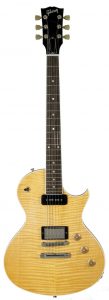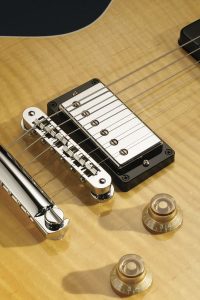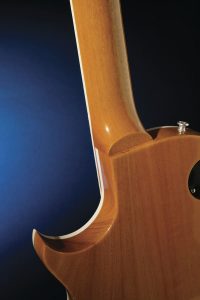Gibson Nighthawk Review
Table of Contents
Among Gibson’s Limited Run series for 2009 is a reissue of a guitar that appeared 16 years ago. Has Gibson Nighthawk Nighthawk time come at last? Review by Martyn Casserly
The Nighthawk was originally introduced by Gibson back in 1993, with a combination of a mini humbucker at the neck and a slanted bridge humbucker aiming it squarely at blues and classic rock players. After only six years in production the model was deemed surplus to requirements, and Gibson dropped it.

Now, 10 years on, the Nighthawk is back with a few changes and high-grade appointments. Are some things are best left in the past?
It wouldn’t really be a Gibson if there wasn’t some mahogany involved, and the Nighthawk obliges with a two-piece Grade A body – with internal chambers – lovingly adorned with a Grade AAA bookmatched maple top.
Design
The top has an attractive 3-D grain with cool stripes in the middle and a few random vertical grain lines near the edges, a nice reminder that real wood is involved. Gibson has gone for a clean white binding which suits the sparse, simple design, and the motif continues onto the mahogany neck with the bound 22-fret rosewood fingerboard.
A nice, flat 12″ radius proves a happy hunting ground for big bends and fast runs, and the frets are all fitted neatly and finished smoothly – something which has not always been the case on Gibsons we’ve seen over the years.

The Gibson Nighthawk shape is an acquired taste. Where a Les Paul’s bottom bout is curvy and voluptuous, the Nighthawk is flatter, allied to a sharp, pointy cutaway that provides excellent access to the upper frets, aided by a none-too-intrusive slim heel at the neck join.
The overall look is not, perhaps, the Rubenesque beauty of its more successful siblings – but when you’re up against some of the most gorgeous designs in history it’s going to be tough to stand out.
Color
Gibson NighthawkThe choice of colour is another questionable decision. Described in the catalogue as a ‘golden-hued translucent amber’ the appearance is more of a pale yellow that makes the Nighthawk look a little anaemic. Colour is a very subjective thing, and some may find this finish to be just what they’re after, but to offer only one option seems to be brave – especially when you remember some of the interesting reds and blues that were used on the Nighthawk’s cousin, the Blueshawk. That said, the nitrocellulose finish has been applied well and it should age and darken nicely over time.
Moving over to the electrics we find a departure from the traditional Nighthawk layout. Instead of the mini-humbucker previously found in the neck we now have a P90, and the slanted bridge humbucker is replaced by a more conventional Gibson 498T ‘bucker at a regular angle.
Controls are slightly unusual for Gibson – a Flying V-style two volumes and a solitary tone all in a line – but the three-way selector on the upper bout restores a semblance of normality. At this point the spectre of quality control rears its head.

Several times our review guitar spluttered and lost sound when selecting the bridge pickup, suggesting that some dodgy wiring was to blame. Hardly the end of the world and easy to fix, but it’s something that shouldn’t be happening.
Hardware is pretty standard, with a Tune-O-Matic bridge, a stop tailpiece and three-a-side vintage-styled tuning pegs.
SOUNDS
Gibson NighthawkPlugged into a valve amp on the clean channel and selecting the P90, we’re presented with a crisp tone that responds well to strong fingerpicking and plectrum-assisted strumming. A softer approach leaves chords sounding a little too woolly around the edges, with the tonal balance slipping as the low E and A strings start to become overbearing.
Mixing the two pickups obviously adds a bit more top end, and judicious adjustment of the volumes can produce an interesting range of sounds.
The bridge humbucker by itself is strident and sharp, with plenty of edge when wound up and fed a little overdrive. Big open chords have body and articulation in the manner of the Who and Queen, while more gain will get you into AC/DC territory and beyond with plenty of chug in the tank.
Sustain for solo lines is very good and the pickups respond well to playing dynamics, although the nagging feeling that haunts the guitar is that it doesn’t really have its own distinctive tone, and leaves us with a sense of being unfulfilled after a playing session.
Gibson Nighthawk Verdict
The Gibson Nighthawk is a quality instrument. It’s easy to play, comfortable to wear due to its extreme light weight, and capable of good sounds. This P90 and humbucker combination has long been a favourite with many players, offering power and versatility at the flick of a switch. So, everything’s cool, then? Well, no. The question that keeps coming up in our mind is who would buy this?’ With the premium grade woods bumping up the price the Nighthawk is obviously not a stripped-down cost-effective blues rocker.
The slightly awkward body shape with its flat top and solitary colour option may also count against it. And when you consider the proximity of Gibson’s own SG Standard in cost, plus guitars like the PRS Mira, the mystery deepens. When the Nighthawk was dropped 10 years ago maybe it was because it never found its audience. It’s hard to see where it’s going to fit in now. At a time when most people are being careful about what they spend. The popularity of the SG and Les Paul only make things harder for a guitar that has neither the heritage or definable vibe of either. It’s a good guitar, possibly a very good guitar. But how long will it stay around for this time?

Leave a Reply
You must be logged in to post a comment.